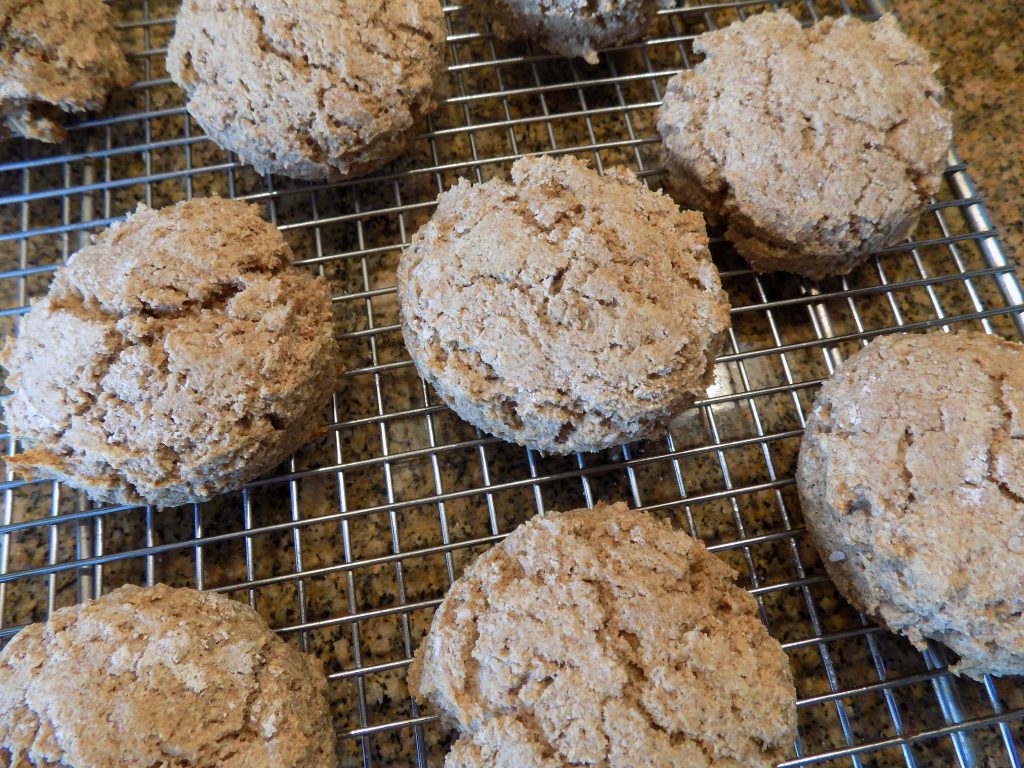
I found the bones of this recipe on the food.com site. I modified the recipe by replacing shortening with unsalted butter and used buttermilk instead of milk. The reason I made the changes is because I grew up on a farm which included a couple of milk cows. My grandmother churned our butter and therefore we had both fabulous unsalted butter and buttermilk in abundance. So, that’s what I watched being used in biscuits by both my mom and my grandmother when I was a child.
The original recipe for rye biscuits posted on the food.com site by Chocolatl first appeared in print in 1908. Chocolatl writes “This is one of a number of historical recipes I am posting from my cookbook collection. This recipe is adapted from the Rumford Complete Cookbook. At the time this recipe was first published, ovens did not have heat regulators, so recipes specified only “hot,” “moderate” or “slow/cool” temperatures. This recipe is also unusual in that it calls for a small egg. Rumford Baking Powder is still being made, by the same company that makes Clabber Girl.”
Since lard was the most common form of shortening until around 1911, I would have thought lard would have been called for in the original recipe. And I’m sure lard would be great in this recipe, but I don’t always have lard on hand. And I’m willing to bet you don’t either.
So, I question the use of “shortening” and “regular milk” in the original recipe. Plus, if you churned your own butter, like many women did in 1908, I bet using the buttermilk to make biscuits was a great way of getting rid of it. I know we always had a small pitcher of buttermilk in our refrigerator. And none of us kids were eager to drink it. In fact, we wouldn’t touch the stuff! So, let there be buttermilk biscuits. (We ate a lot of baking powder biscuits when I was a kid.) (I am not complaining!)
OK, I’ve told you about the ingredients, and why I made the changes I did, now I need to tell you how amazingly easy these biscuits are to prepare, and how fantastic they taste. They are one of the best tasting biscuits I have ever eaten. And they use whole grain rye flour, only a small amount of fat, and absolutely no sugar. Praise God!
For more information about rye flour, see below.
So, if you too love biscuits and are trying to stay away from white flour, sugar, and a lot of fat, these are the biscuits for you. And just so you know, these biscuits are great warmed up and served alongside your breakfast bacon and eggs.
As always, peace and love to all.
2 c. whole grain rye flour – I use Bluebird Grain Farms (Winthrop, Washington) organic Heritage Rye Flour
½ tsp. kosher salt
4 tsp. baking powder
2 T. cold unsalted butter, cut into tiny pieces
1 sm. egg
¾ c. buttermilk
Whisk the flour, baking powder, and salt together. Add the butter and “mix” it in by pinching the small butter pieces between your fingers until most of the butter is smushed into the flour. (Or until you can’t stand playing with your food any longer!)
Whisk the egg and buttermilk together then pour it over the flour mixture. Mix just until combined.
Roll out on a lightly floured board and cut into 8-10 biscuit shapes. Place on a lightly greased baking sheet. Or do what I do. Using a #16 (scant ¼ cup) ice cream scoop, drop level balls of dough on your lightly greased baking sheet. (You should get 10 balls.) Then using a small water glass dipped in a bit of flour, flatten the biscuits slightly.
Bake in a pre-heated 425-degree oven until the bottom of each biscuit is nicely browned, about 15 minutes. Don’t over-bake. Remove from oven and transfer to a wire rack.
Great right out of the oven or lightly warmed in your microwave or toaster oven. Perfect spread with butter and jam or my personal favorite – peanut butter.
The benefits of using rye flour (besides the flavor of course)
Rye contains a myriad of core vitamins and minerals such as potassium and manganese. Moreover, rye has a lower gluten content than wheat, which makes baked goods containing rye flour ideal for those who want to lower the gluten content in the baked goods they consume. In addition, products made with rye flour also make you feel fuller and have less of an impact on blood sugar levels than when white flour is used.
For example, rye bread has a lower glycemic index (48) than wheat bread (70). As you know, the lower the index, the better it is for your health. Because, after the consumption of lower glycemic index food, there is less of a chance of a rapid increase in your blood glucose level. This is especially beneficial for diabetic and obese individuals.
